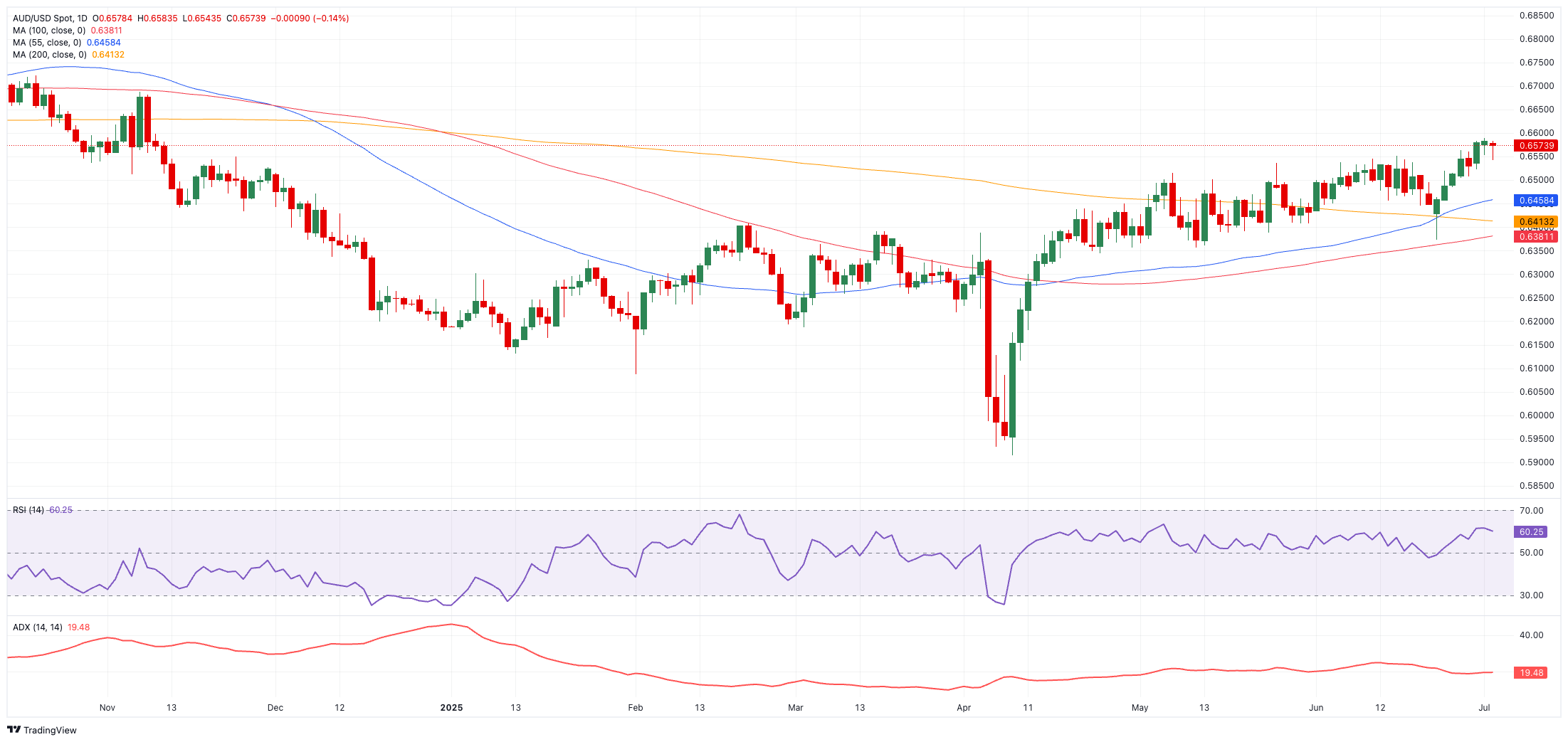
- AUD/USD came under renewed downside pressure, always below 0.6600.
- The US Dollar gathered fresh steam and bounces off multi-year lows.
- Retail Sales in Australia expanded less than estimated in May.
The Australian Dollar (AUD) retreated modestly against the US Dollar (USD) on Wednesday, partially denting the strong recovery that saw AUD/USD hit yearly highs near the 0.6600 hurdle in the previous day
Meanwhile, the pair’s constructive bias appears unchallenged following the so far convincing break above its 200-day Simple Moving Average (SMA) near 0.6420.
On the domestic front, the Ai Group survey fell mostly on the soft side in June, while Retail Sales expanded by 0.2% in May, adding to the sour mood around AUD. Further data saw Building Permits expand by .2% in May and Private House Approvals rise by 0.5% in the same period.
It is worth recalling that May’s consumer price index (CPI) eased to 2.1% YoY from 2.4% in April, comfortably within the Reserve Bank of Australia’s (RBA) 2%–3% target band, while final S&P Global PMI data confirmed that Australia’s manufacturing sector remains in expansion territory.
The CPI slowdown and robust PMI readings underscore resilience in the local economy, lending support to the AUD’s recent advance.
China: Momentum vs headwinds
China, Australia’s largest trading partner, painted a mixed but broadly positive picture: Industrial output, retail sales and services activity all accelerated in May, reinforcing expectations for growth near the 5% annualised mark.
The National Bureau of Statistics (NBS) reported June’s Manufacturing PMI at 49.7 and the Non-Manufacturing PMI at 50.5, while Caixin’s manufacturing PMI climbed to 50.4. Still, strains in the property sector and the gradual withdrawal of stimulus threaten to sap momentum through late 2025.
Central bank divergence
Diverging policy paths continue to shape sentiment.
The RBA trimmed its cash rate by 25 basis points to 3.85% last month, mapping a gradual glide toward 3.20% by 2027 and rebuffing calls for a deeper “insurance” cut.
The Federal Reserve (Fed) held rates steady but reiterated guidance for two 50 bp reductions before year-end, with Chair Jerome Powell warning that tariffs could reignite goods inflation over the summer.
Market bets
Speculators have widened their bearish bets on the AUD. CFTC data to June 24 show net short positions rising to nearly 96K contracts, the highest since April, while open interest climbed to just over 151K contracts, reaching two-week highs.
Technical levels
Resistance lies at 0.6590, the 2025 high set on June 30, followed by the November 2024 peak at 0.6687 and the 2024 ceiling at 0.6942, before the key 0.7000 mark.
On the downside, the 200-day SMA at 0.6418 offers initial support ahead of the June trough at 0.6372 (June 23) and the May low at 0.6356 (May 12), with a deeper slide potentially targeting the 0.6000 milestone and the 2025 bottom at 0.5913 (April 9).
The Relative Strength Index (RSI) hovers near 60, suggesting further upside, while the Average Directional Index (ADX) around 22 indicates a moderately firm trend.
AUD/USD daily chart

Short-term outlook
AUD/USD appears to have broken out of its multi-week consolidation zone. Shifts in Beijing’s policy mix or surprise US trade moves remain the most obvious swing factors, though neither seems imminent. Markets anticipate another modest RBA cut later this year, but the bank is expected to move cautiously rather than pursue aggressive easing. Absent external shocks, the AUD’s constructive stance is likely to hold, with incremental gains favoured as long as the pair remains north of its 200-day SMA.
RBA FAQs
The Reserve Bank of Australia (RBA) sets interest rates and manages monetary policy for Australia. Decisions are made by a board of governors at 11 meetings a year and ad hoc emergency meetings as required. The RBA’s primary mandate is to maintain price stability, which means an inflation rate of 2-3%, but also “..to contribute to the stability of the currency, full employment, and the economic prosperity and welfare of the Australian people.” Its main tool for achieving this is by raising or lowering interest rates. Relatively high interest rates will strengthen the Australian Dollar (AUD) and vice versa. Other RBA tools include quantitative easing and tightening.
While inflation had always traditionally been thought of as a negative factor for currencies since it lowers the value of money in general, the opposite has actually been the case in modern times with the relaxation of cross-border capital controls. Moderately higher inflation now tends to lead central banks to put up their interest rates, which in turn has the effect of attracting more capital inflows from global investors seeking a lucrative place to keep their money. This increases demand for the local currency, which in the case of Australia is the Aussie Dollar.
Macroeconomic data gauges the health of an economy and can have an impact on the value of its currency. Investors prefer to invest their capital in economies that are safe and growing rather than precarious and shrinking. Greater capital inflows increase the aggregate demand and value of the domestic currency. Classic indicators, such as GDP, Manufacturing and Services PMIs, employment, and consumer sentiment surveys can influence AUD. A strong economy may encourage the Reserve Bank of Australia to put up interest rates, also supporting AUD.
Quantitative Easing (QE) is a tool used in extreme situations when lowering interest rates is not enough to restore the flow of credit in the economy. QE is the process by which the Reserve Bank of Australia (RBA) prints Australian Dollars (AUD) for the purpose of buying assets – usually government or corporate bonds – from financial institutions, thereby providing them with much-needed liquidity. QE usually results in a weaker AUD.
Quantitative tightening (QT) is the reverse of QE. It is undertaken after QE when an economic recovery is underway and inflation starts rising. Whilst in QE the Reserve Bank of Australia (RBA) purchases government and corporate bonds from financial institutions to provide them with liquidity, in QT the RBA stops buying more assets, and stops reinvesting the principal maturing on the bonds it already holds. It would be positive (or bullish) for the Australian Dollar.
Information on these pages contains forward-looking statements that involve risks and uncertainties. Markets and instruments profiled on this page are for informational purposes only and should not in any way come across as a recommendation to buy or sell in these assets. You should do your own thorough research before making any investment decisions. FXStreet does not in any way guarantee that this information is free from mistakes, errors, or material misstatements. It also does not guarantee that this information is of a timely nature. Investing in Open Markets involves a great deal of risk, including the loss of all or a portion of your investment, as well as emotional distress. All risks, losses and costs associated with investing, including total loss of principal, are your responsibility. The views and opinions expressed in this article are those of the authors and do not necessarily reflect the official policy or position of FXStreet nor its advertisers. The author will not be held responsible for information that is found at the end of links posted on this page.
If not otherwise explicitly mentioned in the body of the article, at the time of writing, the author has no position in any stock mentioned in this article and no business relationship with any company mentioned. The author has not received compensation for writing this article, other than from FXStreet.
FXStreet and the author do not provide personalized recommendations. The author makes no representations as to the accuracy, completeness, or suitability of this information. FXStreet and the author will not be liable for any errors, omissions or any losses, injuries or damages arising from this information and its display or use. Errors and omissions excepted.
The author and FXStreet are not registered investment advisors and nothing in this article is intended to be investment advice.








